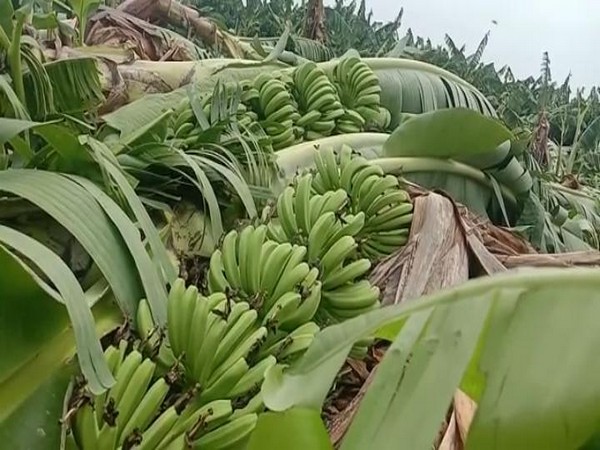IAEA and South America using nuclear science to combat spread of Panama wilt
“When the Andean community reached out to us, we were aware that the condition is serious and that we should use our nuclear expertise to stop any further spread of the disease,” said IAEA Director General Rafael Mariano Grossi.

Considered the most lethal banana disease in the world, the Fusarium wilt or Panama wilt, is a killer that is rapidly spreading in Latin America and hurting global supplies of the world’s most popular export banana variety — the Cavendish. Working hand in hand with experts in South America, the IAEA, in cooperation with the Food and Agriculture Organization of the United Nations (FAO), is using nuclear science to combat, manage and prevent the spread of this disease, save livelihoods and ensure food security.
“When the Andean community reached out to us, we were aware that the condition is serious and that we should use our nuclear expertise to stop any further spread of the disease,” said IAEA Director General Rafael Mariano Grossi.
Bananas are a staple food in much of the region, especially among poorer segments of the population, and are also an important cash crop. Over 84 per cent of bananas are produced by smallholder farmers and supply the domestic markets, while the remaining 16 per cent produced in tropical areas are destined for export.
According to the FAO, the Cavendish banana provides approximately 47 per cent of global banana production and accounts for almost all the bananas exported. If the disease spreads further, economic loss and unemployment is inevitable, scientists say. Indonesia has already seen an estimated US$121 million of economic loss and Colombia, the fifth largest exporter of bananas in the world, is likely to lose 30,000 jobs and US$800 million of export earnings per year if the disease is not controlled quickly.
In late August 2021, experts and authorities from the Andean community — Bolivia, Colombia, Ecuador and Peru — reached out to the IAEA when they discovered continuing spread of the latest variation of the disease, Tropical Race 4 (TR4), in the region. First reported in Latin America in 2019 in Colombia, it was observed in Peru in early 2021.
“When we found that more than 80 hectares of land in Peru and 250 in Colombia had been affected, Bolivia also started to fear that the disease could soon reach its banana plantations. It became clear to us, as a community, that our countries need specialised assistance through nuclear techniques and related biotechnologies to overcome the disease and stop its spread in the Latin American region,” said Antonio Bustamante, Research Technician at the National Institute of Agricultural Research of Ecuador, a country exporting the most bananas worldwide.
TR4 is a soil borne pathogen, meaning that it can survive for decades in the soil and destroy healthy plants grown in the soil — causing crop loss and making the disease difficult to control. With the pathogen found in 20 countries during the past decade, the IAEA is providing support to stop the disease from escalating further.The Andes taking action against Fusarium wilt diseaseThe IAEA and the FAO have put together an emergency technical cooperation project to strengthen international capacity to prevent and contain the disease through surveillance, early detection, genetic resistance and integrated management.
“We use irradiation to modify the plant material to develop disease resistant varieties as well as use the nuclear-derived technique of polymerase chain reaction (PCR) or DNA sequencing to detect the disease and stop its spread,” explained Najat Mokhtar, IAEA Deputy Director General and Head of the Nuclear Sciences and Applications Department.
Innovative research and development activities over the last seven years at the IAEA through the Joint FAO/IAEA Centre of Nuclear Techniques in Food and Agriculture made it now possible to deliver tailor-made technical support to fight TR4 in banana. Thanks to these activities and technical support, researchers have made significant progress in the use of radiation-induced genetic variation to develop resistance against TR4 in banana. Ongoing studies at the Joint FAO/IAEA Centre in cell and tissue culture are expected to further accelerate the pace of developing genetic resistance in banana even further, as they constitute an important component of the rapid response to TR4 management.
The best long-term solution to tackle the Panama wilt disease is genetic resistance, said experts at the Joint FAO/IAEA Centre. During the first course of the disease in the early 20th century, the variety of banana most commonly known today, Cavendish, replaced the previously popular Gros Michel variety which was prone to an earlier variant of the pathogen. Through plant mutation breeding, new disease resistance varieties of the Cavendish can be developed, which has already been seen in China.
Controlling the spread of any disease or virus relies on early and rapid detection, quarantine and containment. The same applies to TR4. By using PCR, scientists can confirm the identity of the pathogen on bananas and clarify whether they are diseased. If they are detected sufficiently early, they can be destroyed straight away, and containment measures can be taken before infecting neighbouring plantations.
“Building on the research and development activities carried out by the IAEA through the Joint FAO/IAEA Centre, the TC programme is now able to provide support to countries whose agriculture is suffering from Fusarium wilt disease. By working together on a global scale, we can build capacities to stop the disease spreading further and avoid a global banana pandemic destroying one of the world’s favourite fruits,” said Hua Liu, IAEA Deputy Director General and Head of the Technical Cooperation Department.
- READ MORE ON:
- Mariano Grossi
- FAO
- IAEA
- Panama
- South America










